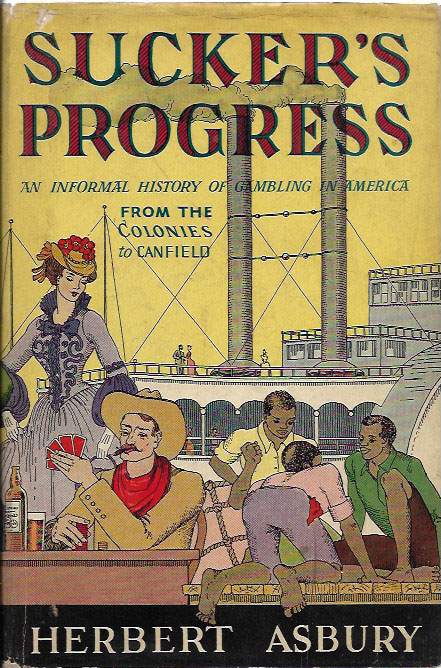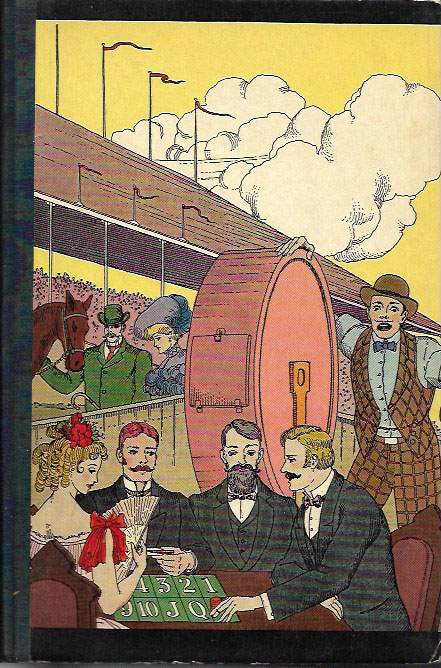- Name Book: Sucker’s Progress: an informal history of gambling in America from the colonies to Canfield
- Author: Herbert Asbury
- Year: 1938
- Publisher: Dodd, Mead & Co.
- Location: New York, USA

Sucker’s Progress: an informal history of gambling in America from the colonies to Canfield By Herbert Asbury, (1938, New York / Dodd, Mead & Co.)
Sucker’s Progress: an informal History of Gambling in America from the colonies to Canfield is a fantastic book full of stories and proper historical research. It can be no surprise that Herbert Asbury mentions Canfield in the book. Almost 100 years ago, Herbert Asbury did the same research as me, trying to solve the mystery of what Solitaire was played at Canfield.
Quote from Sucker’s Process about what game was played at Canfield
“The only form of Solitaire ever played in an American gambling house was a game in which the bank sold a pack of cards for fifty-two dollars and paid the player five dollars for each pip visible on the ace pile when the game had ended, kings being rated at thirteen, queens at twelve, and jacks at eleven. This game had a brief vogue in a few New York resorts around 1905 and 1906 and is still the most widely played of all Solitaire games, though not for money. Its proper name is either Can- field or Klondike, or both; it was originally copyrighted as Can- field, and is called Canfield by almost everyone who plays it today, but it is described as Klondike in all of the Hoyle’s Games and Official Rules of Card Games which have been published since 1912. It is popularly supposed to have been devised by Richard Canfield, but as a matter of fact that famous gambler never invented it, and there is no record that he ever played it or that it was ever used in any of his gambling houses.”
“The present author made a diligent effort to trace the origin of the game, but ran into a curious maze of confusion, complicated by the fact that there was also a dice game known as Klondike, which was played in virtually all of the second-class houses in New York around 1900. Apparently the first time the card game appeared in print as Canfield was in 1908, when it was published in Dick’s Games of Patience or Solitaire, edited by Harris B. Dick and issued in New York by Dick & Fitz-Gerald. Dick’s description of the game carries the line, Copyright 1908 by Dick & Fitzgerald and this comment: “This game has attained a certain degree of notoriety as having been employed as a game of chance” In this book there is no mention of Klondike. But in Hoyle’s games, autograph edition, copyright 1907 by the McClure company and in 1913 and 1914 by A L Burt Company, Canfield is not mentioned, and two versions of Klondike are given, with the significant notation: There are several ways of playing this game “One version, called Seven Card Klondike, is the game that Harris B.Dick described and copyrighted as Canfield. The other, called Klondike, is a different game, but with enough points of similarity to indicate that it sprang from the same source as Seven Card Klondike”
“In Lady Cadogan’s Illustrated Games of Solitaire or Patience, copyright 1914 and published in Philadelphia by David McKay, the game which Dick called Canfield is described as Canfield or Klondike.
In his Complete Hoyle, an Encyclopedia of Games, a monumental work copyrighted in 1914 and published in October of that year by Frederick A. Stokes Company of New York, R. F. Foster describes as Klondike the game which Harris B. Dick had copyrighted as Canfield, and says that “this game is sometimes mistakenly called Canfield”
The game which Hoyle’s Games, Autograph Edition, published as Klondike also appears in Foster’s book, but is called Canfield, with the comment that “this form of solitaire is often confused with Klondike.”
The 1913 edition of the Official Rules of Card Games, which has been published every year or two since 1887 by the United States Playing Card Company of Cincinnati, described the Harris B. Dick game and called it Canfield or Klondike. Subsequent editions, however, including that of 1937, followed Foster.
Of forty or fifty other books on card games which were consulted, some described the Harris Dick game as Canfield, some call it Klondike, and some gave two games, as Foster had done.One conclusion which may be drawn from the Canfield Klondike situation is that there were two versions of Klondike, and that Harris B Dick took advantage of Richard’s Canfield’s notoriety, chose the version which was being played in the gambling houses, called it Canfield.
Another conclusion, possibly more logical, is that the whole thing is a mess”
